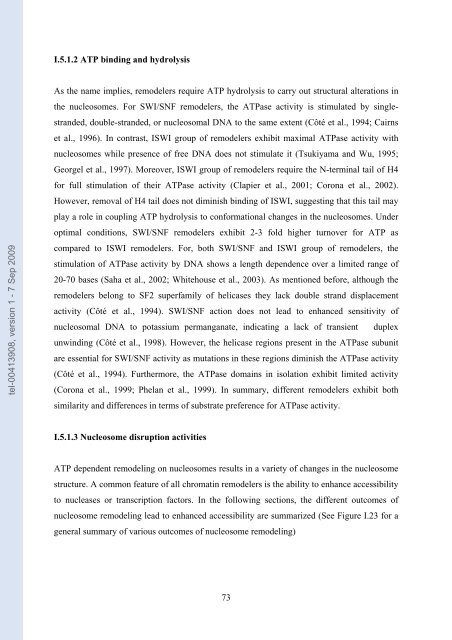Etudes sur le mécanisme de remodelage des nucléosomes par ...
Etudes sur le mécanisme de remodelage des nucléosomes par ...
Etudes sur le mécanisme de remodelage des nucléosomes par ...
You also want an ePaper? Increase the reach of your titles
YUMPU automatically turns print PDFs into web optimized ePapers that Google loves.
tel-00413908, version 1 - 7 Sep 2009<br />
I.5.1.2 ATP binding and hydrolysis<br />
As the name implies, remo<strong>de</strong><strong>le</strong>rs require ATP hydrolysis to carry out structural alterations in<br />
the nuc<strong>le</strong>osomes. For SWI/SNF remo<strong>de</strong><strong>le</strong>rs, the ATPase activity is stimulated by sing<strong>le</strong>-<br />
stran<strong>de</strong>d, doub<strong>le</strong>-stran<strong>de</strong>d, or nuc<strong>le</strong>osomal DNA to the same extent (Côté et al., 1994; Cairns<br />
et al., 1996). In contrast, ISWI group of remo<strong>de</strong><strong>le</strong>rs exhibit maximal ATPase activity with<br />
nuc<strong>le</strong>osomes whi<strong>le</strong> presence of free DNA does not stimulate it (Tsukiyama and Wu, 1995;<br />
Georgel et al., 1997). Moreover, ISWI group of remo<strong>de</strong><strong>le</strong>rs require the N-terminal tail of H4<br />
for full stimulation of their ATPase activity (Clapier et al., 2001; Corona et al., 2002).<br />
However, removal of H4 tail does not diminish binding of ISWI, suggesting that this tail may<br />
play a ro<strong>le</strong> in coupling ATP hydrolysis to conformational changes in the nuc<strong>le</strong>osomes. Un<strong>de</strong>r<br />
optimal conditions, SWI/SNF remo<strong>de</strong><strong>le</strong>rs exhibit 2-3 fold higher turnover for ATP as<br />
com<strong>par</strong>ed to ISWI remo<strong>de</strong><strong>le</strong>rs. For, both SWI/SNF and ISWI group of remo<strong>de</strong><strong>le</strong>rs, the<br />
stimulation of ATPase activity by DNA shows a <strong>le</strong>ngth <strong>de</strong>pen<strong>de</strong>nce over a limited range of<br />
20-70 bases (Saha et al., 2002; Whitehouse et al., 2003). As mentioned before, although the<br />
remo<strong>de</strong><strong>le</strong>rs belong to SF2 superfamily of helicases they lack doub<strong>le</strong> strand displacement<br />
activity (Côté et al., 1994). SWI/SNF action does not <strong>le</strong>ad to enhanced sensitivity of<br />
nuc<strong>le</strong>osomal DNA to potassium permanganate, indicating a lack of transient dup<strong>le</strong>x<br />
unwinding (Côté et al., 1998). However, the helicase regions present in the ATPase subunit<br />
are essential for SWI/SNF activity as mutations in these regions diminish the ATPase activity<br />
(Côté et al., 1994). Furthermore, the ATPase domains in isolation exhibit limited activity<br />
(Corona et al., 1999; Phelan et al., 1999). In summary, different remo<strong>de</strong><strong>le</strong>rs exhibit both<br />
similarity and differences in terms of substrate preference for ATPase activity.<br />
I.5.1.3 Nuc<strong>le</strong>osome disruption activities<br />
ATP <strong>de</strong>pen<strong>de</strong>nt remo<strong>de</strong>ling on nuc<strong>le</strong>osomes results in a variety of changes in the nuc<strong>le</strong>osome<br />
structure. A common feature of all chromatin remo<strong>de</strong><strong>le</strong>rs is the ability to enhance accessibility<br />
to nuc<strong>le</strong>ases or transcription factors. In the following sections, the different outcomes of<br />
nuc<strong>le</strong>osome remo<strong>de</strong>ling <strong>le</strong>ad to enhanced accessibility are summarized (See Figure I.23 for a<br />
general summary of various outcomes of nuc<strong>le</strong>osome remo<strong>de</strong>ling)<br />
73

















